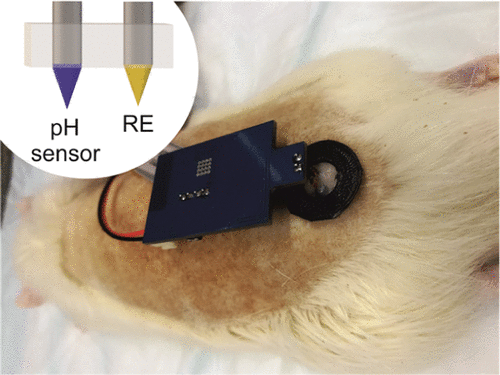Our official English website, www.x-mol.net, welcomes your feedback! (Note: you will need to create a separate account there.)
Toward In Vivo Transdermal pH Sensing with a Validated Microneedle Membrane Electrode
ACS Sensors ( IF 8.9 ) Pub Date : 2021-02-10 , DOI: 10.1021/acssensors.0c02397 Juan José García-Guzmán 1 , Clara Pérez-Ràfols 1 , María Cuartero 1 , Gastón A. Crespo 1
ACS Sensors ( IF 8.9 ) Pub Date : 2021-02-10 , DOI: 10.1021/acssensors.0c02397 Juan José García-Guzmán 1 , Clara Pérez-Ràfols 1 , María Cuartero 1 , Gastón A. Crespo 1
Affiliation

|
We present herein the most complete characterization of microneedle (MN) potentiometric sensors for pH transdermal measurements for the time being. Initial in vitro assessment demonstrated suitable analytical performances (e.g., Nernstian slope, linear range of response from 8.5 to 5.0, and fast response time) in both buffer media and artificial interstitial fluid (ISF). Excellent repeatability and reproducibility together with adequate selectivity and resiliency facilitate the appropriateness of the new pH MN sensor for transdermal ISF analysis in healthcare. The ability to resist skin insertions was evaluated in several ex vivo setups using three different animal skins (i.e., chicken, pork, and rat). The developed pH MN sensor was able to withstand from 5 to 10 repetitive insertions in all the skins considered with a minimal change in the calibration graph (<3% variation in both slope and intercept after the insertions). Ex vivo pH measurements were validated by determining the pH with the MN sensor and a commercial pH electrode in chicken skin portions previously conditioned at several pH values, obtaining excellent results with an accuracy of <1% and a precision of <2% in all cases. Finally, pH MN sensors were applied for the very first time to transdermal measurements in rats together with two innovative validation procedures: (i) measuring subcutaneous pH directly with a commercial pH microelectrode and (ii) collecting ISF using hollow MNs and then the pH measurement of the sample with the pH microelectrode. The pH values obtained with pH MN sensors were statistically more similar to subcutaneous measurements, as inferred by a paired sample t-test at 95% of confidence level. Conveniently, the validation approaches could be translated to other analytes that are transdermally measured with MN sensors.
中文翻译:

使用经过验证的微针膜电极实现体内透皮pH值检测
我们目前在这里为pH透皮测量的微针(MN)电位传感器的最完整的表征。最初的体外评估表明,在缓冲液和人工间隙液(ISF)中均具有合适的分析性能(例如Nernstian斜率,从8.5到5.0的线性响应范围和快速的响应时间)。出色的可重复性和可重复性,以及足够的选择性和回弹力,使得新型pH MN传感器适用于医疗保健中的经皮ISF分析。在几个离体体内评估了抵抗皮肤插入的能力使用三种不同的动物皮(即鸡肉,猪肉和老鼠)进行设置。研发的pH MN传感器能够在考虑的所有皮肤中承受5至10次重复插入,并且校准曲线的变化很小(插入后斜率和截距的变化均小于3%)。离体通过使用MN传感器和市售pH电极确定先前已在多个pH值条件下进行调节的鸡皮部分中的pH值来验证pH测量值,从而获得了优异的结果,在所有情况下,其准确度均<1%,准确度<2%。最后,首次将pH MN传感器与两种创新的验证程序一起应用于大鼠的经皮测量:(i)使用商业pH微电极直接测量皮下pH,以及(ii)使用空心MN收集ISF,然后进行pH测量带有pH微电极的样品。由pH MN传感器获得的pH值在统计学上更类似于皮下测量,这是由配对样品t推断得出的。-在95%的置信水平下进行测试。验证方法可以方便地转换为其他使用MN传感器经皮测量的分析物。
更新日期:2021-03-26
中文翻译:

使用经过验证的微针膜电极实现体内透皮pH值检测
我们目前在这里为pH透皮测量的微针(MN)电位传感器的最完整的表征。最初的体外评估表明,在缓冲液和人工间隙液(ISF)中均具有合适的分析性能(例如Nernstian斜率,从8.5到5.0的线性响应范围和快速的响应时间)。出色的可重复性和可重复性,以及足够的选择性和回弹力,使得新型pH MN传感器适用于医疗保健中的经皮ISF分析。在几个离体体内评估了抵抗皮肤插入的能力使用三种不同的动物皮(即鸡肉,猪肉和老鼠)进行设置。研发的pH MN传感器能够在考虑的所有皮肤中承受5至10次重复插入,并且校准曲线的变化很小(插入后斜率和截距的变化均小于3%)。离体通过使用MN传感器和市售pH电极确定先前已在多个pH值条件下进行调节的鸡皮部分中的pH值来验证pH测量值,从而获得了优异的结果,在所有情况下,其准确度均<1%,准确度<2%。最后,首次将pH MN传感器与两种创新的验证程序一起应用于大鼠的经皮测量:(i)使用商业pH微电极直接测量皮下pH,以及(ii)使用空心MN收集ISF,然后进行pH测量带有pH微电极的样品。由pH MN传感器获得的pH值在统计学上更类似于皮下测量,这是由配对样品t推断得出的。-在95%的置信水平下进行测试。验证方法可以方便地转换为其他使用MN传感器经皮测量的分析物。



























 京公网安备 11010802027423号
京公网安备 11010802027423号